Oracle Park
Oracle Park is a baseball park located in the South Beach neighborhood of San Francisco, California. Since 2000, it has served as the home of the San Francisco Giants, the city's Major League Baseball (MLB) franchise. Originally named Pacific Bell Park, then SBC Park, then AT&T Park, the stadium's current name was adopted in 2019.[9] The park stands along the San Francisco Bay, a segment of which is named McCovey Cove in honor of former Giants player Willie McCovey.
 | |
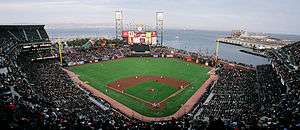 Oracle Park (then known as AT&T Park) during the Giants game on April 8, 2008 | |
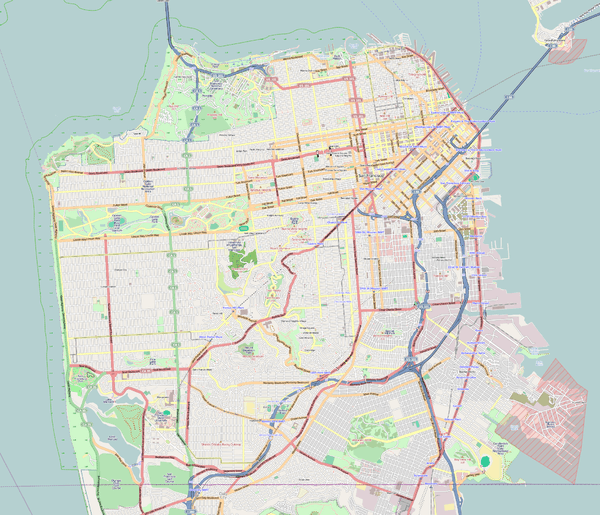 Oracle Park Location in San Francisco  Oracle Park Location in California  Oracle Park Location in the United States | |
| Former names | Pacific Bell Park (2000–2003) SBC Park (2004–2005) AT&T Park (2006–2018) |
|---|---|
| Address | 24 Willie Mays Plaza |
| Location | San Francisco, California |
| Coordinates | 37°46′43″N 122°23′21″W |
| Public transit | at 2nd and King Station
|
| Owner | Port of San Francisco |
| Operator | San Francisco Baseball Associates LP |
| Capacity | Baseball:
1,500 standing-room capacity NCAA Football:
Soccer:
Rugby sevens:
|
| Record attendance | 44,046 (2010 NLDS, Game 2, Braves) |
| Field size | Left field line – 339 feet (103 m) Left field – 364 feet (111 m) Left-center field – 399 feet (122 m) Center field – 391 feet (119 m) Right-center field – 415 feet (126 m) Right field – 365 feet (111 m) Right field line – 309 feet (94 m) 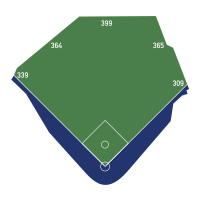 |
| Surface | Tifway 419 Bermuda Grass |
| Construction | |
| Broke ground | December 11, 1997 |
| Opened | April 11, 2000 |
| Renovated | 2019-2020 |
| Construction cost | $357 million ($530 million in 2019 dollars[3]) |
| Architect | Populous (then HOK Sport)[4] |
| Project manager | Alliance Building Partners[5] |
| Structural engineer | Thornton Tomasetti[6] |
| Services engineer | M-E Engineers, Inc.[7] |
| General contractor | Hunt/Kajima[8] |
| Tenants | |
| San Francisco Giants (MLB) (2000–present) San Francisco Demons (XFL) (2001) Kraft Fight Hunger Bowl (NCAA) (2002–2013) California Redwoods (UFL) (2009) California Golden Bears (NCAA) (2011) | |
Oracle Park has also played host to both professional and collegiate American football games. The stadium was the home of the annual college postseason bowl game now known as the Redbox Bowl from its inaugural playing in 2002 until 2013, and also served as the temporary home for the University of California's football team in 2011. Professionally, it was the home of the San Francisco Demons of the XFL and the California Redwoods of the United Football League.
Public transit access to the stadium is provided within San Francisco by Muni Metro or Muni Bus, from the Peninsula and Santa Clara Valley via Caltrain, and from parts of the Bay Area across the water via various ferries of San Francisco Bay. The Muni 2nd and King Station is directly outside the ballpark, the 4th & King Caltrain station is 1.5 blocks from the stadium, and the Oracle Park Ferry Terminal is outside the east edge of the ballpark beyond the center field bleachers.
History
Design and construction
Originally designed to be a 42,000-seat stadium, there were slight modifications before the final design was complete. When the ballpark was brought to the ballot box in the fall of 1996 for voter approval, the stadium was 15° clockwise from its current position. Also the center-field scoreboard was atop the right-field wall and the Giants Pavilion Building were two separate buildings.[10] Groundbreaking on the ballpark began on December 11, 1997, in the industrial waterfront area of San Francisco known as China Basin in the up-and-coming neighborhoods of South Beach and Mission Bay. The stadium cost $357 million to build and supplanted the Giants' former home, Candlestick Park, a multi-use stadium in southeastern San Francisco that was also home to the NFL's San Francisco 49ers until 2014, when they relocated to Levi's Stadium in Santa Clara. A team of engineers from UC Davis was consulted in the design process of the park, resulting in wind levels that are approximately half those at Candlestick. Fans had shivered through 40 seasons at "The 'Stick" and looked forward to warmer temperatures at the new ballpark.[11] But because Oracle Park, like its predecessor, is built right on San Francisco Bay, cold summer fog and winter jackets in July are still not unusual at Giants games, despite the higher average temperature.
When it opened on March 31, 2000, the ballpark was the first MLB ballpark built without public funds since the completion of Dodger Stadium in 1962.[12] However, the Giants did receive a $10 million tax abatement from the city and $80 million for upgrades to the local infrastructure (including a connection to the Muni Metro).[13] The Giants have a 66-year lease on the 12.5-acre (51,000 m2) ballpark site, paying $1.2 million in rent annually to the San Francisco Port Commission.[12] The park opened with a seating capacity of 40,800, but this has increased over time as seats have been added. In April 2010, the stadium became the first MLB ballpark to receive LEED Silver Certification for Existing Buildings, Operations and Maintenance.[14]
Following the 2019 season, the organization began the process of relocating the bullpens from the first- and third base foul lines to behind the outfield walls in center and right-centerfield. The motivation was two-fold: to address player safety issues that had arisen over the years by having the bullpen mounds in the field of play, and to slightly alter the dimensions of the park to perhaps increase, if ever-so-slightly, the potential for home runs in certain areas of the outfield,[15] most notably in right-center field, affectionately known as Triples Alley (a design feature meant as an homage to the centerfield depth of the Giants former home in New York, The Polo Grounds). Prior to these modifications, multiple players both home and away had experienced various levels of injury sustained by tripping over the bullpen mounds while chasing foul balls. Most notably, former Giants outfield prospect Mac Williamson sustained a concussion during such a play that significantly altered his season.[16]
Naming rights
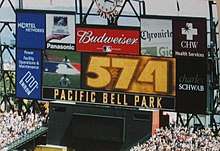
On April 3, 1996, Pacific Bell, a telephone company serving California based in San Francisco, purchased the naming rights for the planned ballpark for $50 million for 24 years. The stadium was named Pacific Bell Park, or Pac Bell Park for short.[17]
Just days before the sponsorship was announced, SBC Communications had announced their intention to acquire Pacific Bell's parent company, Pacific Telesis, a deal which closed in April 1997. SBC eventually stopped using the Pacific Bell name for marketing, and reached an agreement with the Giants to change the stadium's name to SBC Park on January 1, 2004.[17]
After SBC bought AT&T Corporation on November 18, 2005, the name of the merged company became AT&T Inc. As a result, in 2006 the stadium was given its third name in six years: AT&T Park.[17]
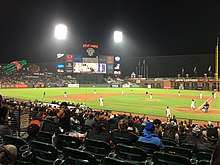
On January 9, 2019, it was reported that AT&T had given the Giants the option of ending the naming deal a year early, if the team could quickly find a new partner.[18] The Giants and Oracle Corporation came to a rapid agreement, with the old AT&T Park signs being replaced with temporary Oracle Park banners on January 10.[19]
Some fans still refer to the stadium as Pac Bell Park, as it was the first name given to the stadium. Others have nicknamed the stadium "The Phone Booth" or "Telephone Park", in response to its multiple name changes, while some referred to the stadium as "Some Big Corporation Park" during the SBC years. Others yet refer to it as "Mays Field" in honor of Giants great Willie Mays or simply "The Bell".[20] Many also refer to the stadium as "China Basin" or "McCovey Cove" after its location, which would be immune to changes in sponsorship naming.
2020 Renovations
In December 2019, the San Francisco Giants revealed that they would be renovating the center field section of Oracle Park. The renovation took place from December 2019 to June 2020. The Bullpens moved from foul territory into center field. The Giants decided to make their garden smaller to fit the bullpens behind the center-field wall. With this renovation, the dimensions of the park have slightly shrunk. Left-center trimmed down from 404 feet to 399 feet, right-center (known as Triples Alley) has trimmed down the 421 feet to 415 feet (to represent the San Francisco area code), and dead-center trimmed down the 399 feet to 391 feet, making it the second shortest dead-center field distance in the MLB, behind Fenway Park in Boston. With this renovation, approximately 650 bleacher seats had to be removed to create more fan engagement. Now there are patios for fans to watch the relief pitchers warm-up from up close.
Features
The stadium contains 68 luxury suites, 5,200 club seats on the club level, and an additional 1,500 club seats at the field level behind home plate.
On the facing of the upper deck along the left-field line are the retired numbers of Bill Terry, Mel Ott, Carl Hubbell, Monte Irvin, Willie Mays, Barry Bonds, Juan Marichal, Orlando Cepeda, Jackie Robinson, Willie McCovey, and Gaylord Perry, as well as the retired uniforms, denoted "NY", of Christy Mathewson and John McGraw who played or managed in the pre-number era. These two pre-number–era retired uniforms are among only six such retired uniforms in all of the Major Leagues.
Oracle Park has a reputation of being a pitcher's park and the most pitcher-friendly ballpark in the National League, because the depth of the outfield limits home runs, according to ESPN.[21] ESPN's MLB Park Factors lists Oracle Park as having the fewest home runs per game 6 out of the past 7 years, the one exception coming in 2013, when it was the 3rd lowest.
Right field and McCovey Cove
The most prominent feature of the ballpark is the right-field wall, which is 24 feet (7.3 m) high in honor of former Giants Willie Mays, who wore number 24. Because of the proximity to the San Francisco Bay, the right-field foul pole is only 309 feet (94.2 m) from home plate, the shortest in the NL [only Fenway Park's shorter, at 302 feet (92.0 m)]. The wall is made of brick, with fenced-off archways opening to the Cove beyond, above which are several rows of arcade seating. The fence angles quickly away from home plate; right-center field extends out to 421 feet (128.3 m) from home plate. Atop the fence are four pillars with fountains atop. Jets of water burst from the four pillars at the end of the National Anthem and also when the Giants hit a home run or win a game.
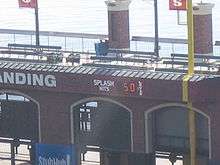
In the past, rubber chickens put up by fans whenever a Giants player (especially Barry Bonds) was intentionally walked, would line the foul portion of the wall. The fans would do this to show that the opposing team is "chicken" for not pitching right to the Giants players. In recent seasons, as the team's strength has shifted from hitting to pitching, fans will line up "K" signs with each strikeout by a Giants pitcher. The right field area was designed to resemble the Polo Grounds. This deep corner of the ballpark has been dubbed "Death Valley" and "Triples Alley." Like its Polo Grounds counterpart, it is very difficult to hit a home run to this area, and a batted ball that finds its way into this corner often results in a triple. It is 421 feet (128 m).[22] Triples Alley is also infamous for bad bounces, most notably when Ichiro Suzuki hit the first-ever inside-the-park home run in an All-Star Game by lining the ball off one of the archways and sideways past the outfielders. Nate Schierholtz performed the same feat in the 2009 season as a pinch hitter. Aubrey Huff did it again in the 2010 season, as did Conor Gillaspie in 2011. Ángel Pagán ended a game in May 2013 with a two-run walk-off inside-the-park home run, the first of its kind at the then-named AT&T Park.
Beyond right field is China Basin, a section of San Francisco Bay, which is dubbed McCovey Cove after famed Giants first baseman and left-handed slugger Willie McCovey, and into which a number of home runs have been hit on the fly. As of July 29, 2020, 82 "splash hits" (all by a lefty batter) have been knocked into the Cove by Giants players since the park opened; 35 of those were by Barry Bonds, and the most recent being Mike Yastrzemski hitting one off Matt Strahm of the San Diego Padres on July 29, 2020. These hits are tallied on an electronic counter on the right field wall. Opponents have hit the water on the fly 46 times; Todd Hundley of the Los Angeles Dodgers was the first visitor to do so on June 30, 2000. Curtis Granderson of the New York Mets, Luis Gonzalez of the Arizona Diamondbacks and Cliff Floyd of the Chicago Cubs are the only visiting players to do so twice, while Carlos Delgado of the New York Mets has performed the feat three times. Adam LaRoche has also hit three splash hits, twice with the Arizona Diamondbacks and once with the Pittsburgh Pirates. Shin-Soo Choo of the Texas Rangers most recently hit one into the water as a visiting player on August 2, 2020. On June 27, 2010, David Ortiz of the Boston Red Sox became the first American League player to hit a splash hit. The only other AL players who have done it are Mitch Moreland of the Texas Rangers on June 9, 2012, Adam Dunn of the Chicago White Sox on August 13, 2014, Rougned Odor of the Texas Rangers on August 24, 2018, and Shin-Soo Choo of the Texas Rangers on August 2, 2020. Barry Bonds is the Giant who has hit the most home runs into "The Cove" as Giants fans call it and is the only one to have had hit 2 splash hits in one game (a feat he accomplished twice).[23]
Behind the scoreboard in center field there is a pier where ferries can tie up and let off fans right at the park. On game days, fans take to the water of McCovey Cove in boats and even in kayaks, often with fishing nets in the hope of collecting a home run ball. (This echoes what used to happen at Candlestick Park during McCovey's playing days. Before Candlestick's upper deck was extended, the area behind right field was occupied by three small bleacher sections and a lot of open space. Kids in those bleachers would gather behind the right field fence when "Stretch" came to the plate.) Just beyond the wall behind the King Street ballpark is a public waterfront promenade. Across the cove from the ballpark is McCovey Point and China Basin Park, featuring monuments to past Giants legends.
| List of Home Team Splash Hits[23] | |||||||||||||||||||||||||||||||||||||||||||||||||||||||||||||||||||||||||||||||||||||||||||||||||||||||||||||||||||||||||||||||||||||||||||||||||||||||||||||||||||||||||||||||||||||||||||||||||||||||||||||||||||||||||||||||||||||||||||||||||||||||||||||||||||||||||||||||||||||||||||||||||||||||||||||||||||||||||||||||||||||||||||||||||||||||||||||||||||||||||||||||||||||||||||||||||||||||||||||||||||||||||||||||
|---|---|---|---|---|---|---|---|---|---|---|---|---|---|---|---|---|---|---|---|---|---|---|---|---|---|---|---|---|---|---|---|---|---|---|---|---|---|---|---|---|---|---|---|---|---|---|---|---|---|---|---|---|---|---|---|---|---|---|---|---|---|---|---|---|---|---|---|---|---|---|---|---|---|---|---|---|---|---|---|---|---|---|---|---|---|---|---|---|---|---|---|---|---|---|---|---|---|---|---|---|---|---|---|---|---|---|---|---|---|---|---|---|---|---|---|---|---|---|---|---|---|---|---|---|---|---|---|---|---|---|---|---|---|---|---|---|---|---|---|---|---|---|---|---|---|---|---|---|---|---|---|---|---|---|---|---|---|---|---|---|---|---|---|---|---|---|---|---|---|---|---|---|---|---|---|---|---|---|---|---|---|---|---|---|---|---|---|---|---|---|---|---|---|---|---|---|---|---|---|---|---|---|---|---|---|---|---|---|---|---|---|---|---|---|---|---|---|---|---|---|---|---|---|---|---|---|---|---|---|---|---|---|---|---|---|---|---|---|---|---|---|---|---|---|---|---|---|---|---|---|---|---|---|---|---|---|---|---|---|---|---|---|---|---|---|---|---|---|---|---|---|---|---|---|---|---|---|---|---|---|---|---|---|---|---|---|---|---|---|---|---|---|---|---|---|---|---|---|---|---|---|---|---|---|---|---|---|---|---|---|---|---|---|---|---|---|---|---|---|---|---|---|---|---|---|---|---|---|---|---|---|---|---|---|---|---|---|---|---|---|---|---|---|---|---|---|---|---|---|---|---|---|---|---|---|---|---|---|---|---|---|---|---|---|---|---|---|---|---|---|---|---|---|---|---|---|---|---|---|---|---|---|---|---|---|---|---|---|---|---|---|---|---|---|---|---|---|---|---|---|---|---|---|---|---|---|---|---|---|---|---|---|---|---|---|
|
Rusty, the Coke bottle, and the glove
When the park opened in 2000, taking residence on the right field wall was Rusty, the Mechanical Man based on a theme of Old Navy since the wall was sponsored by the company. Rusty was a two-dimensional robotic ballplayer that stood 14 feet (4.3 m) tall and weighed 5½ tons. The Valencia-based firm, Technifex, engineered, fabricated and programmed Rusty to appear after major plays, during games, as a fully animated giant 1920s-era tin "toy". After technical problems arose with Rusty, it was removed from the Old Navy Splash Landing, though the enclosure that housed him remained for years. In 2006 the Old Navy sponsorship of the wall was terminated and renamed "Levi's Landing". In 2008, the enclosure was removed as that area near the right field foul pole was renovated for a new luxury party suite called the "McCovey Cove Loft".[24]
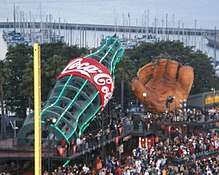
Behind the left field bleachers is "The Coca-Cola Fan Lot". The ballpark features an 80-foot (24 m) long Coca-Cola bottle with playground slides that lights up with every Giants home run, and a miniature version of the stadium. "The Coca-Cola Superslide" is popular with children as is with adults, and the terraced levels of the slides are a fun way to catch the game. Bubbles originally accompanied the bottle, but never worked as intended and were removed. If one were viewing the outfield promenade from home plate, directly to the bottle's right is another oversized representation of a ballpark stalwart, the "Giant 1927 Old-Time Four-Fingered Baseball Glove" — this particular one is made of steel and fiberglass. Behind and farther to the left is "The Little Giants Park" – a miniature baseball diamond — sort of a minor league tryout for Pee-Wee Ball.[25]
To the right of the glove sculpture is the elevator and large plaza area for functions and parties to be held during games. It's also the site of "Orlando's", the concessions stand of Giants great Orlando Cepeda. The signature fare at the stand is the "Caribbean Cha Cha Bowl". Right-center field features a real San Francisco cable car numbered 44 (retired cable car #4, formerly #504) in honor of Giants great Willie McCovey. Originally, the cable car had a label that stated "No Dodgers Fans Allowed", as well as one end of the car numbered 24 in honor of Willie Mays and the other end numbered 44 in honor of Willie McCovey.[26] The foghorn — a feature introduced at Candlestick Park by the current Giants ownership group – was transferred to Oracle and hung underneath the scoreboard. It blows when a Giants player hits a home run or at the conclusion of a Giants win. Continuing right takes one to the promenade above the Cove, so that one can make a completely uninterrupted circuit of the park at that concourse level. Both levels of the concourse, inside the stadium, feature not only concession stands of all sorts, but other attractions as well.
@Café
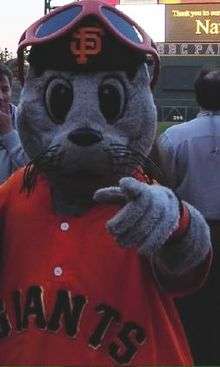
Located behind the centerfield bleachers, the ballpark features the @Café,[27] a social media café, which opened in the 2013 season. The cafe serves Peet's Coffee and features large screens that show off fans' social media posts from Facebook, Twitter, and Instagram, which are curated by the Giants organization.
The cafe replaced a team-themed Build-A-Bear Workshop store, where fans could build their own stuffed Giants' mascot, Lou Seal, or create other Giants-themed stuffed animals.
Scoreboards
In addition to the automated scoreboards, which now include a new HD videoboard by Mitsubishi, the park has enormous manually-operated boards on the right field wall, which display the scores of Major League games being played elsewhere. The manual scoreboards are operated by three employees, whose work on game days starts at least two hours before the first pitch. A members-only bar, Gotham Club, is located behind the manual scoreboard, complete with a bowling alley and pool tables. Former players and VIPs are the only patrons of this exclusive area. Three other ballparks also use hand-operated out-of-town scoreboards: Fenway Park, Minute Maid Park & Wrigley Field.
Wireless internet
Starting in 2004, the Giants installed 122 wireless internet access points, covering all concourses and seating areas, creating one of the largest public hotspots in the world[28] at the time.
San Francisco Giants Wall of Fame
- For the inductees' names, see: San Francisco Giants § San Francisco Giants Wall of Famers
On September 23, 2008, the Giants Wall of Fame was unveiled on the King Street side of the ballpark,[29] as part of the 50th-anniversary celebration of the Giants' move to San Francisco. 48 retired players were inducted, based on longevity and achievement.[30] Eligibility requirements for players to be on the Wall are either five years as a San Francisco Giant with an All-Star Game appearance or nine years as a Giant.[31] Rich Aurilia and Shawn Estes were added in 2010.[32] Jason Schmidt and Marvin Benard were added in 2011, and Barry Bonds was added in 2017.[33]
| Giants Home Attendance at Oracle Park | |||
|---|---|---|---|
| Season | Attendance | Avg./Game | Rank |
| 2000 | 3,318,800 | 40,973 | 2nd |
| 2001 | 3,311,958 | 40,888 | 1st |
| 2002 | 3,253,203 | 40,163 | 1st |
| 2003 | 3,264,898 | 40,307 | 1st |
| 2004 | 3,256,854 | 39,718 | 3rd |
| 2005 | 3,181,023 | 39,272 | 3rd |
| 2006 | 3,130,313 | 38,646 | 4th |
| 2007 | 3,223,215 | 39,793 | 5th |
| 2008 | 2,863,837 | 35,356 | 7th |
| 2009 | 2,862,110 | 35,335 | 7th |
| 2010 | 3,037,443 | 37,499 | 5th |
| 2011 | 3,387,303 | 41,819 | 2nd |
| 2012 | 3,377,371 | 41,696 | 2nd |
| 2013 | 3,369,106 | 41,593 | 3rd |
| 2014 | 3,368,697 | 41,589 | 3rd |
| 2015 | 3,375,882 | 41,678 | 3rd |
| 2016 | 3,365,256 | 41,546 | 3rd |
| 2017 | 3,303,652 | 40,785 | 3rd |
| 2018 | 3,156,185 | 38,965 | 3rd |
| 2019 | 2,707,760 | 33,429 | 7th |
| Source:[34] | |||
Statues
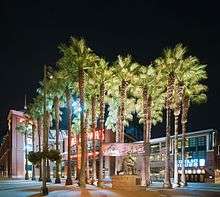
Outside the ballpark are six statues, five of which are dedicated to San Francisco Giants all-time greats.
The Willie Mays Statue is located in front of the ballpark entrance at 24 Willie Mays Plaza and is surrounded with 24 palm trees, in honor of his number 24 uniform, retired by the Giants. It was dedicated at noon on March 31, 2000, prior to the opening of the ballpark and was commissioned by Giants Managing Partner Peter Magowan and his wife Debby.[35]
Another statue is located at McCovey Point across McCovey Cove, and is dedicated to Willie McCovey. Around the Willie McCovey Statue are a number of plaques that celebrate the winners of the Willie Mac Award. The statue is located at China Basin Park next to The Barry Bonds Junior Giants Field, a T-ball park. Also located on the sea wall promenade are plaques showing the Opening Day roster of every Giants team from 1958 through 1999. Giants fans who contributed funds to China Basin Park, had their own tiles with their own inscriptions set into the wall.[36]
A third statue, dedicated in 2005, honors former Giants pitcher Juan Marichal, and is located outside the ballpark at the Lefty O'Doul Gate entrance. The fourth statue is located at the park's ferry plaza behind center field, also known as Seals Plaza; a statue of a seal bobbing a baseball on its nose honors the memory of the San Francisco Seals, the minor league baseball club that played before the arrival of the Giants in 1958.
On September 6, 2008, during a series against the Pittsburgh Pirates, a fifth statue depicting former Giants great Orlando Cepeda was dedicated at the corner of 2nd and King Streets next to the ballpark. A sixth statue, dedicated on August 13, 2016, honors former Giants pitcher Gaylord Perry and is also located at the corner of 2nd and King Streets next to the ballpark. All five statues of the Giants Hall of Fame players were created by sculptor William Behrends of North Carolina.

Left field Chevron banner and ground rules issues
A feature of the ballpark is the long-running Chevron advertisement, located in left field, featuring an outline of the company's claymation Chevron Cars, though the top 'roofs' of the cars (along with a dog and a surfboard hanging out a car window) are extended out (though with traditional structure and cushioning behind it),[37] rendering it several inches higher than the wall base, and creating a ground rules issue. Several instances where potential over-the-wall catches to take away home runs were thwarted have occurred because of the advertisement's top dimensions: for example, during Game 3 of the 2016 NLDS against the Chicago Cubs, Kris Bryant hit a ball well into left field. Giants left fielder Gregor Blanco attempted a catch, but the ball landed on the roof of one of the cars, past the wall and out of his reach, rendering it a home run and tying the game in the top of the ninth inning (though the Giants would win the game in extra innings for their only win in the series).[38] There are also apocryphal stories of Giant players jokingly saying they would saw the tops of the Chevron cars off if they resulted in opposing home runs being unable to be caught.
Climate
| ||||||||||||||||||||||||||||||||||||||||||||||||||||||||||||||||||||||||||||||||||||||||||||||||||||||||||||||||||||||||||||
Notable events
2000s
The opening series took place April 11–13, 2000 against the Los Angeles Dodgers (the team the Giants faced in their final series at Candlestick Park), and the Giants were swept in three games. In the first game of that series, the Giants lost 6–5, highlighted by three home runs from the Dodgers' Kevin Elster. On May 1, 2000, Barry Bonds became the first player to hit a "splash hit" home run into McCovey Cove.
In just its first few years of existence, the ballpark saw its share of historic events primarily due to veteran Giants outfielder Barry Bonds. On April 17, 2001, Bonds hit his 500th career home run at then-Pacific Bell Park. Later that year, he set the single season home run record when he hit home runs number 71, 72, and 73 over the weekend of October 5 to close the season. On August 9, 2002, Bonds hit his 600th career home run at the park. On April 12, 2004, Bonds hit career home run 660 at SBC Park to tie Willie Mays for third on the all-time list and on the next night, he hit number 661 to move into sole possession of third place. On September 17, 2004, Bonds hit his 700th career home run at the park to become just the third member of baseball's 700 club. On May 28, 2006, Bonds hit his 715th home run at the park to pass Babe Ruth for second place on the all-time list. On August 7, 2007, Bonds hit his 756th home run, breaking Hank Aaron's record.
The park hosted games three through five of the 2002 World Series against the Anaheim Angels, which the Giants lost four games to three. It also hosted the 2007 MLB All-Star Game, which the American League won 5–4 over the National League.
On July 10, 2009, the Giants' Jonathan Sánchez pitched the first no-hitter at Oracle Park.
2010s
On October 27 & 28, 2010, the Giants hosted the first two games of the World Series, beating the Texas Rangers in both games. They ultimately went on to win the series four games to one, their first championship since the team moved to San Francisco in 1958, though the clinching game was played at Rangers Ballpark in Arlington rather than at Oracle Park.
On June 13, 2012, Matt Cain threw the 22nd perfect game in MLB history — and first in Giants history — against the Houston Astros.
Oracle Park hosted Games 1 and 2 of the 2012 World Series on October 24 and 25. The Giants beat the Detroit Tigers twice, 8–3 and 2–0 respectively. The Giants would go on to win the 2012 World Series in a four-game sweep at Comerica Park.
The stadium hosted of the semifinal and final rounds of the 2013 World Baseball Classic on March 17–19.
On July 23, 2013, due to a previous rain-out in Cincinnati, Oracle Park served as the "home" venue of the Cincinnati Reds for the second game of a doubleheader against the Giants.[40] Giants manager Bruce Bochy won his 1,500th career game.
On June 25, 2014, Tim Lincecum pitched the 3rd no hitter at Oracle Park against the San Diego Padres in a 4–0 win. It was his 2nd no hitter of his career, with both of them coming against the Padres.
Oracle Park hosted Games 3, 4, and 5 of the 2014 World Series on October 24, 25 and 26. The Giants beat the Kansas City Royals 2 out of the 3 games played at Oracle Park, losing Game 3, 3–2, before winning Games 4 and 5, 11–4 and 5–0 respectively. They ultimately went on to win the series in seven games, with the clinching game played at Kauffman Stadium rather than at Oracle Park. As of 2019, the Giants have not hosted a World Series clincher at Oracle Park, but they did host two at Candlestick Park: the first being in 1962, which was won by the New York Yankees, and the second in 1989, which the Oakland Athletics won in a four-game sweep.
On June 15, 2015, the Giants set a record for most consecutive home losses at Oracle Park at nine straight games with a 5–1 loss to the Seattle Mariners. This losing streak was the Giants' longest since an 11-game home loss streak at the Polo Grounds in New York in 1940.[41]
From October 1, 2010 to July 18, 2017, Oracle Park recorded 530 consecutive sellouts, the second longest in Major League history behind Fenway Park's 794 consecutive sellouts from 2003 to 2013.
Non-baseball events
Giants Enterprises, a wholly owned subsidiary of the San Francisco Giants created and headed by longtime team executive Pat Gallagher, brings non-baseball events to Oracle Park on days when the Giants do not play. Prominent among these has been the usage of the stadium for football. It has also hosted a range of other sporting and musical events.
Football
The park was home to the XFL's San Francisco Demons in 2001, was the home of the East-West Shrine Game (until 2006), and was the former home stadium of the California Redwoods of the UFL in 2009.
From 2002 to 2013, it was also home to college football's Redbox Bowl when the game was known as the San Francisco Bowl, Emerald Bowl, and Fight Hunger Bowl. In 2011, Oracle Park became the temporary home football stadium for the California Golden Bears while Cal's on-campus stadium, California Memorial Stadium, underwent renovation.[42]
Oracle Park also hosted its first high school football game in 2011, the Central Coast Section Division III football championship game between long-time San Francisco rivals St. Ignatius College Preparatory and Sacred Heart Cathedral Preparatory.[43]
In January 2019, it was reported that the Oakland Raiders had considered temporarily moving to Oracle Park for the 2019 NFL season, as an interim measure before construction of a stadium in their new home city of Las Vegas is complete for 2020.[44] However, the 49ers refused to waive their territorial rights,[45] and the Raiders would ultimately reach an agreement with the Oakland-Alameda County Coliseum Authority to return to the Oakland Coliseum for the 2019 season with a provision for the 2020 season should construction of Allegiant Stadium be delayed.[46]
Soccer
On February 10, 2006, the U.S. men's soccer team defeated Japan 3–2 at Oracle in a friendly.
A match of the 2011 World Football Challenge between Manchester City and Club America was held at Oracle, drawing a crowd of 11,250.
On March 17, 2012, the Houston Dynamo defeated the San Jose Earthquakes 1–0 in a regular season Major League Soccer match at Oracle.
On July 31, 2013, Everton defeated Juventus 6-5 on penalties after ending regulation tied 1-1 as part of the 2013 International Champions Cup.[47]
| Date | Winning Team | Result | Losing Team | Tournament | Spectators |
|---|---|---|---|---|---|
| February 10, 2006 | 3–2 | International Friendly | 37,365 | ||
| July 16, 2011 | 2–0 | 2011 World Football Challenge | 11,250 | ||
| March 17, 2012 | 1–0 | Major League Soccer | 21,816 | ||
| July 31, 2013 | 1–0 | 2013 International Champions Cup | 22,208 |
Concerts
| Date | Artist | Opening act(s) | Tour / Concert name | Attendance | Revenue | Notes |
|---|---|---|---|---|---|---|
| May 18, 2001 | Dave Matthews Band | Macy Gray Angelique Kidjo | Summer 2001 Tour | 73,056 / 73,056 | $3,634,536 | Carlos Santana and Karl Perazzo were special guests.[48] |
| May 19, 2001 | Trey Anastasio was the special guest.[49] | |||||
| November 8, 2002 | The Rolling Stones | Sheryl Crow | Licks Tour | — | — | |
| November 9, 2002 | ||||||
| August 16, 2003 | Bruce Springsteen and the E Street Band | — | The Rising Tour | 40,702 / 40,702 | $3,134,054 | |
| August 12, 2005 | Dave Matthews Band | The Black Eyed Peas Jem | Summer 2005 Tour | 50,786 / 55,000 | $2,920,195 | |
| September 24, 2005 | Green Day | Jimmy Eat World Flogging Molly | American Idiot World Tour | 45,000 / 45,000 | $1,875,675 | |
| November 13, 2005 | The Rolling Stones | Metallica Everclear | A Bigger Bang | 87,054 / 88,264 | $11,210,733 | |
| November 15, 2005 | ||||||
| November 29, 2007 | Fall Out Boy | Gym Class Heroes Plain White T's Cute Is What We Aim For Doug | Young Wild Things Tour | — | — | |
| June 8, 2008 | Kenny Chesney | Brooks & Dunn LeAnn Rimes Gary Allan Luke Bryan | Poets and Pirates Tour | 34,328 / 37,033 | $3,036,391 | |
| July 18, 2009 | Kenny Chesney | Lady Antebellum Miranda Lambert | Sun City Carnival Tour | 36,258 / 37,411 | $2,516,347 | |
| July 10, 2010 | Paul McCartney | — | Up and Coming Tour | 40,512 / 40,512 | $4,752,027 | This show marked his first performance in the city since The Beatles performed at Candlestick Park in 1966. |
| May 11, 2012 | Roger Waters | — | The Wall Live | 33,193 / 33,193 | $4,151,510 | |
| August 5, 2014 | Beyoncé & Jay Z | — | On the Run Tour | 73,020 / 73,020 | $8,887,539 | |
| August 6, 2014 | ||||||
| September 5, 2015 | Billy Joel | Gavin DeGraw | Billy Joel in Concert | 37,064 / 37,064 | $3,924,448 | |
| September 25, 2015 | AC/DC | Vintage Trouble | Rock or Bust World Tour | 46,167 / 46,167 | $4,446,189 | |
| February 6, 2016 | Metallica | Cage the Elephant | WorldWired Tour | 41,119 / 43,681 | $4,341,114 | |
| August 9, 2016 | Guns N' Roses | The Struts | Not in This Lifetime... Tour | 38,173 / 38,173 | $5,597,843 | |
| September 4, 2016 | Journey | The Doobie Brothers | Eclipse Tour | — | — | |
| August 13, 2017 | Lady Gaga | DJ White Shadow | Joanne World Tour | 39,225 / 39,225 | $4,674,972 | |
| November 9, 2017 | Metallica | Dave Matthews G-Eazy Dead & Company Raphael Siddiq Rancid |
WorldWired Tour | 38,387 / 38,387 | $3,547,160 | Band Together concert for Northern California wildfire relief[50] |
| August 21, 2018 | Ed Sheeran | Snow Patrol Anne-Marie | ÷ Tour | 38,647 / 38,647 | $4,199,073 | |
| September 20, 2018 | Eagles | Zac Brown Band | An Evening With The Eagles 2018 | TBA | TBA | |
| September 21, 2018 | Def Leppard Journey | Foreigner | Def Leppard & Journey 2018 Tour | 35,617 / 35,617 | $3,915,971 | |
| July 21, 2020 | Green Day Fall Out Boy Weezer | The Interrupters | Hella Mega Tour | TBA | TBA |
Rugby
The stadium hosted the 2018 Rugby World Cup Sevens from July 20 to 22.[51]
In video games
A virtual recreation of the park was created as a gig venue for Guitar Hero World Tour.
In the game Watch Dogs 2, a stadium, called Nudle Park, based on Oracle Park is recreated. Its location is also in San Francisco, and is in the same region.
The stadium is featured in the MLB 2K series as well as PlayStation's MLB: the Show.
In TV
In summer 2010, the park hosted an audition stop for the 2011 (10th) season of American Idol.
During the finale of The Amazing Race 30, the park was the first location visited by teams after they arrived in San Francisco, with teams having to find a clue next to the Willie Mays Statue and then kayaking for baseballs in McCovey Cove.[52]
Other events
The stadium hosted an AMA Supercross Championship round from 2003 to 2010.[53]
The Mavericks big-wave surfing contest is broadcast live on the giant video display at Oracle Park when the event is held. In 2006, the park hosted ICER AIR the first stadium big-air ski and snowboard competition to be held in the United States.
San Francisco Opera partnered with Giants Enterprises to do three broadcasts, most recently Tosca, in June and September 2009.
In October 2013, rapper Kanye West rented out the stadium and the scoreboard for a private event, which turned out to be an elaborate marriage proposal to his girlfriend, reality personality Kim Kardashian.[54]
Starting in 2015, the stadium began hosting commencement exercises for San Francisco State University.
References
- "The San Francisco Giants' AT&T Park". Major League Baseball Advanced Media. Retrieved September 17, 2007.
- Crumpacker, John (May 11, 2010). "Cal Football to Temp at AT&T Park". San Francisco Chronicle. Retrieved December 4, 2013.
- Federal Reserve Bank of Minneapolis. "Consumer Price Index (estimate) 1800–". Retrieved January 1, 2020.
- "AT&T Park". Populous. Archived from the original on September 28, 2009. Retrieved June 9, 2014.
- "Team". Alliance Building Partners. Archived from the original on March 6, 2014. Retrieved December 4, 2013.
- "AT&T Park". Thornton Tomasetti. Retrieved December 4, 2013.
- King, John (April 11, 2000). "Neighbor-Friendly Lighting At Stadium Earns a Halo". The San Francisco Chronicle. Retrieved May 8, 2012.
- "AT&T Park". Ballparks.com. Archived from the original on July 12, 2010. Retrieved December 4, 2013.
- Keeling, Brock (January 9, 2019). "AT&T Park is now called Oracle Park". Curbed SF. Retrieved April 2, 2019.
- Epstein, Edward (February 25, 1997). "The Giants' Grand Designs / Statue of Willie Mays to Grace New Ballpark". San Francisco Chronicle. Retrieved June 9, 2014.
- "Engineering: Taking the Wind Out of Baseball". UC Davis Magazine. Archived from the original on June 11, 2010. Retrieved September 18, 2007.
- "Privately Built Pacific Bell Park a Curse to Other Teams". Lawrence Journal-World. Associated Press. October 22, 2002. Archived from the original on September 30, 2007. Retrieved September 18, 2007.
- Gordon, Jon (May 14, 2004). "In San Francisco, the Giants Went Private for Their Stadium". Minnesota Public Radio. Retrieved September 17, 2007.
- "AT&T Park Becomes the First Major League Ballpark to Receive LEED Silver Certification for Existing Buildings, Operations and Maintenance" (Press release). Major League Baseball Advanced Media. April 21, 2010. Retrieved August 14, 2013.
- "Giants announce Oracle Park changes with new dimensions". NBCS Bay Area. December 12, 2019. Retrieved February 11, 2020.
- Cavalieri, Dom (February 26, 2019). "Mac Williamson on concussion last season: 'I had never endured some of the things I endured last year in my life'". KNBR-AF. Retrieved February 11, 2020.
- Raine, George (February 4, 2006). "It's Official: SBC Park Becomes AT&T March 1 / S.F. Giants Will Be Playing Ball on Field's Second Name Change Since Opening in 2000". San Francisco Chronicle. Retrieved August 13, 2012.
- Haft, Chris (January 9, 2019). "Giants, Oracle agree to naming rights deal". SFGiants.com. MLB Advanced Media. Retrieved January 17, 2019.
- Schulman, Henry (January 9, 2019). "SF Giants' home now called Oracle Park after AT&T split". San Francisco Chronicle. Retrieved January 15, 2019.
- Swartz, Jon (April 10, 2000). "Baseball Gets Wired In San Francisco". Forbes. Retrieved June 21, 2017.
- "2013 MLB Park Factors". ESPN. Retrieved June 9, 2014.
- Zimmerman, Douglas. "Report: SF Giants considering removing Triples Alley". SFGate. Retrieved April 17, 2019.
- "AT&T Park Splash Hits". MLB.com. Retrieved July 30, 2020.
- AT&T Park's new McCovey Cove Loft "Suite Of Dreams Debuts At AT&T Park" Archived April 15, 2010, at the Wayback Machine March 7, 2008
- "AT&T Ballpark Attractions". Major League Baseball Advanced Media. Retrieved December 4, 2013.
- "No. 44 - Retired/Ballpark (maroon/light blue) | Market Street Railway". Streetcar.org. Retrieved April 17, 2019.
- Elder, Jeff (June 18, 2013). "Welcome to AT&T Park's New Social Media Cafe – Home of the Giant Tweetdeck". San Francisco Chronicle. Retrieved June 9, 2014.
- "Giants Wi-Fi Network". Major League Baseball Advanced Media. Retrieved December 4, 2013.
- Haft, Chris (September 23, 2008). "Giants Honor Greats with Wall of Fame". Major League Baseball Advanced Media. Retrieved June 9, 2014.
- "Wall of Fame". San Francisco Giants official website. MLB Advanced Media, L.P. Retrieved April 8, 2012.
- Haft, Chris (September 22, 2008). "Giants to Unveil 'Wall of Fame'". Major League Baseball Advanced Media. Retrieved June 9, 2014.
- Haft, Chris (July 24, 2010). "Aurilia, Estes to Join Giants Wall of Fame". Major League Baseball Advanced Media. Retrieved December 4, 2013.
- Haft, Chris (July 8, 2017). "Barry Bonds added to Giants Wall of Fame". MLB.com. Retrieved April 17, 2019.
- "San Francisco Giants Attendance". Baseball-Reference. Retrieved October 7, 2017.
- Epstein, Edward (August 7, 1998). "'All Choked Up / Giants Legend Willie Mays Is Moved By Statue of Him for New Ballpark'". San Francisco Chronicle. Retrieved December 4, 2013.
- "San Francisco Giants McCovey Point And China Basin Park". Major League Baseball Advanced Media. Retrieved December 4, 2013.
- Krieger, Todd (April 10, 2016). "@ToddKrieger1: @MLBcathedrals @JoeMaskivish Imagine the ire of fans of their team's hitter hitting the "car tops" preventing a HR". Twitter. Retrieved January 11, 2019.
- Sullivan, Paul (October 16, 2016). "The car bomb, the catch and a night to remember". Chicago Tribune. Retrieved January 11, 2019.
- "NASA Earth Observations Data Set Index". NASA. Retrieved January 30, 2016.
- Sheldon, Mark (July 16, 2013). "Cincinnati Reds Set to Call San Francisco Home for Game 1 of Doubleheader". Major League Baseball Advanced Media. Retrieved December 4, 2013.
- Giants' home skid nearly a franchise record. Sports Xchange June 16, 2015 "Archived copy". Archived from the original on June 17, 2015. Retrieved June 17, 2015.CS1 maint: archived copy as title (link) Retrieved June 17, 2015
- "Cal Football to Play 2011 Home Season at San Francisco's AT&T Park" (Press release). University of California, Berkeley Athletics. May 10, 2010. Archived from the original on August 14, 2011. Retrieved January 24, 2011.
- Stephens, Mitch (November 30, 2011). "CCS Division III Title Game Set for AT&T Park". San Francisco Chronicle. Retrieved December 4, 2011.
This will be the first high school football game played at Oracle (the two schools have played baseball games there as part of the Bruce-Mahoney series).
- "NFL continuing to study feasibility of Oracle Park for Raiders". CBSSports.com. Retrieved February 4, 2019.
- "Raiders not expected to play in San Francisco in 2019". NFL.com. February 5, 2019.
- Teope, Herbie (February 25, 2019). "Raiders, Coliseum Authority reach agreement for 2019". NFL. Retrieved February 25, 2019.
- Roberts, Chris (July 31, 2013). "European Soccer Giants Juventus and Everton Square Off at AT&T Park". NBC Bay Area. Retrieved September 10, 2019.
- "DMBAlmanac.com²". Dmbalmanac.com. Retrieved April 17, 2019.
- "DMBAlmanac.com²". Dmbalmanac.com. Retrieved April 17, 2019.
- "Northern California Wildfire Relief Benefit Concert". Metallica. October 24, 2017. Archived from the original on October 25, 2017. Retrieved October 25, 2017.
- "USA Rugby set to host RWC Sevens 2018 tournament".
- Walker, Jodi (February 22, 2018). "The Amazing Race finale recap: 'It's Just a Million Dollars, No Pressure'". Entertainment Weekly. Retrieved January 6, 2020.
- 2015 AMA Supercross media guide American Motorcyclist Association
- Garchik, Leah (October 22, 2013). "Kanye's S.F. Proposal to Kim Kardashian". San Francisco Chronicle. Retrieved May 24, 2014.
External links
| Wikimedia Commons has media related to AT&T Park. |
- Oracle Park: Official website of Oracle Park in San Francisco
- William Behrends sculptures at AT&T Park
- Oracle Park Seating Chart
.svg.png)